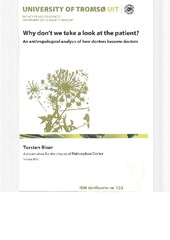| dc.description.abstract | The present thesis is a study of how doctors learn to make clinical decisions; decisions about diagnosis and
therapy of the individual patient in the context of the clinic. It is based on ethnographic fieldwork and
anthropological analysis carried out in 2006-2009. The key informants are nine doctors who go through
internship and the empirical field is the wards and clinics of regional hospitals, university hospitals and
general practice.<br>
The thesis is in three parts. The first part is the design of the study. This includes reviews of clinical
reasoning (Chapter 1) and medical education (Chapter 2); the conceptualization of clinical decision-making
(Chapters 3-4) and the development of a theoretical framework of learning (Chapter 5); a presentation of
ethnographic fieldwork as methodological approach with special considerations of auto-ethnography
(Chapters 6-7); and a description of the process of analysis (Chapter 8).<br>
The second part is the findings of the study. This is made up by four chapters, which each describe one of
four processes of construction in decision-making and how the interns learn to participate in these
constructions. Each of these chapters is followed by a chapter, which discuss conditions of clinical work
that facilitate this learning. Chapter 9 describes the construction of relations, and Chapter 10 discusses the
dynamics of clinical space as the context for these relations. Chapter 11 describes the construction of
decisions, and Chapter 12 discusses the relation between these decisions and the norms and ideals for
clinical reasoning, including evidence-based medicine. Chapter 13 describes the construction of
information, and Chapter 14 discusses the clinical language which interns must learn to use in
communication. Chapter 15 describes the construction of action, and Chapter 16 discusses the moral
aspects of clinical practice and how the local moral economy guide clinical practice.<br>
The interns are found to learn the practice of participating in complex interactional processes of decision
making. Through this process they develop an identity as professional. They learn to adapt to local
conditions for clinical work. They learn to search for problems which are simple and acute, to solve these
through technical rapid action, and to express their reasoning through a specialized clinical language in line
with local spectrums of normality. This is described as the <i>per astra </i> pathway.<br>
In this extensive learning process, they come to embody the norms and traditions of the various clinical
settings. This makes them effective in clinical practice, but also generates a special blindness in the clinical
gaze. When uncertainty or wonder arise in clinical encounters, they have little experience in deliberate
reflection and creative interaction, and they learn instead to revert to the general decision pathway above.<br>
Parallel to this empirical track of the project is a search for, and development of, a theoretical perspective
able to describe clinical decision-making in practice. This is presented in the third part of the thesis and
discussed in relation to the empirical findings. Chapter 17 presents the synthesis of the theoretical track of
the project in <i>the Prometheus perspective</i> and <i>the Clinic Action CycIe.</i> Chapter 18 explores how same of the
interns’ actions may be reinterpreted as a potential for learning in the light of the new perspective. Chapter
19 suggests how it may serve as a framework for discussion and development of decision-making in the
context of medical education and clinical practice. The new perspective differs from established
conceptualizations of clinical reasoning, and epistemological groundwork and continued research of clinical
practice is needed to unfold the potential of this new perspective. Chapter 20 presents an integrated
summary of the empirical and the theoretical track of the project. | en_US |


 English
English norsk
norsk